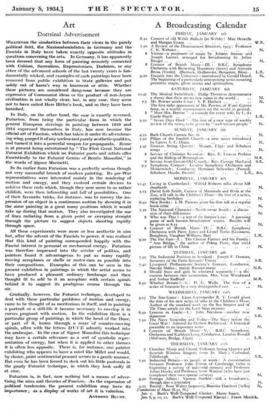Art
Doctrinal Advertisement
WHATEVER the similarities between their views in the purely political field,. the Nazionalsozialisten in Germany and the Fascists in Italy have taken exactly opposite attitudes in questions concerning, the arts In Germany, it has apparently been deemed that any form of painting remotely connected with Cubism, Surrealism, Expressionism, Dadaism, or any other of the advanced schools of the last twenty years is fun- damentally wicked, and examples of such paintings have been removed from public exhibition in State galleries and put safely out of harries way in basement or attic. Whether these pictures are considered dangerous because they are expressive of Communist ideas or the product of non-Aryan civilization is not -wholly clear, but, in any case, they seem not to have suited Herr Hitler's book, and so they have been banished.
In Italy, on the other hand, the ease is exactly reversed. Futurism, from being the particular form in which the general European strivings in painting between 1910 and 1914 expressed themselves in Italy, has now become the official art of Fascism, which has taken it under its all-embrac- ing wing, purged it of any useless and purely aesthetic qualities; and turned it into a powerful weapon for propaganda. Rome. is at present being entertained by" The First Great National Futurist Exhibition- which we Futurist poets and artists offer Fascistically to the Futurist Genius of Benito Mussolini," in the worth of Signor Marinetti.
• fn its earlier form Futurism was a perfectly serious though not very successful branch of modern painting. Its pre-War representatives were interested mainly in the rendering of motion- and energy, and they evolved certain devices to achieve these ends which, though they now seem to us rather childish, were then interesting and felt of possibilities. One of their favourite tricks, for instance, was to convey the im- pression of an object in a continuous motion by showing it in the same painting in a great many positions which it would take up during that motion. They also investigated the use of lines radiating from a given point or sweeping straight through the picture to suggest objects shooting rapidly through space.
All these experiments were more or less aesthetic in aim but, after the advent of the Fascists to power, it was realized that this kind of painting corresponded happily with the Fascist interest in personal or mechanical energy. Futurism Was therefere impressed' into the service of politics, and painters found it advantageous to put as many rapidly Moving aeroplanes or shells or motor-cars as possible into their compositions. Examples of this can be seen in the present exhibition in paintings in which the artist seems to have produced a pleasant ordinary landscape and then thought fit to add to it an aeroplane with certain spirals behind it to suggest its prodigious course through the air.
Gradually, however, the Futurist technique, developed to deal with these particular problems of motion and energy, came to be thought of as meritorious in. itself, and in painting a portrait or a still-life it became necessary to envelop it in curves pregnant with motion. In. the exhibition there is a particular group of paintings in which the head of the Duce, or part of it, looms through a maze of counter-moving spirals, often with the letters D TJCE adroitly worked into the arabesque. In the case of Signor Mussolini this technique may have a. certain relevance as a sort of symbolic repre- Sentation of energy, but when it is applied to other themes it is often less. a:pposite. There is, for instance, one painter exhibiting who appears to have a mind like Millet and would, tvy choice, paint sentimental peasant Scenes in a gentle manner. But even he has been Kneed to 'deck out his little pastorals in the gaudy Futurist technique, in which they look sadly ill at ease: Futurism is* in. fact, now nothing but a means of adver- tising the aims. and. theories of Fascism. As the expression of political tendencies the present exhibition may have its importance ; as a display of works of art it is valueless.
ANTHONY BLUNT.






































 Previous page
Previous page